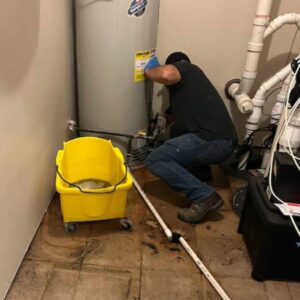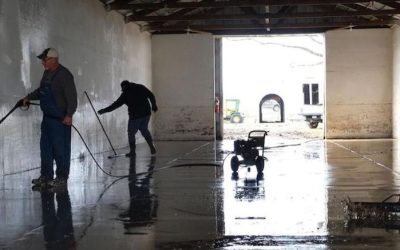
Sewage backups are messy, stressful, and risky to your health. If one strikes your home or business, you do not have to panic. With a clear plan, smart safety steps, and the right help, you can protect your property and get life back to normal quickly. Here is how to handle a sewage emergency, what cleanup involves, when to DIY versus calling a pro, and what you can expect from The CleanUP Guys.
Why sewage backs up in the first place
Understanding the cause helps you fix the right problem and reduce the chance of a repeat.
Tree root intrusion in old or clay sewer lines
Grease buildup and flushed items that do not belong in drains
Collapsed or cracked sewer laterals
Heavy rain that overwhelms combined sewers
Sump pump or backwater valve failure
Blocked floor drains or main line clogs
If the backup returns after you clear a drain, or multiple fixtures back up at once, the issue is likely in the main line and needs professional attention.
First steps to stay safe
Sewage is Category 3 water, which can contain bacteria, viruses, and chemicals. Put safety first.
Keep people and pets away from affected areas
Shut off electricity to wet rooms if you can access the breaker safely
Avoid touching contaminated water without gloves and boots
Do not run your HVAC, it can spread contaminants
Open windows for fresh air if conditions allow
Call your insurance carrier to start a claim and ask about next steps
If the backup is active, avoid using sinks, toilets, and appliances that drain into the affected line.
DIY vs professional cleanup
Small, surface level incidents may look manageable, but sewage carries health risks that are not always visible. Here is a quick way to think about it.
DIY might be reasonable when:
The spill is minor, less than a small bathroom area
The source is stopped, and the water did not touch porous materials
You have proper PPE, disposable tools, and EPA registered disinfectants
Call a professional when:
More than a few square feet are affected
The water soaked drywall, insulation, carpet, pads, or wood subfloor
You smell strong sewage odors or see visible sludge
The backup came from a floor drain or main line
Immunocompromised or elderly people live or work in the property
You need documentation for insurance
Pros follow strict biohazard protocols, track hidden moisture, and prevent mold, which is why professional cleanup is the safer choice for most sewage events.
What professional sewage cleanup involves
A certified team like The CleanUP Guys follows a clear, step by step process:
- Emergency assessment and containment
We inspect for safety hazards, identify the source, and set up containment barriers and negative air to prevent cross contamination.
- Source control and extraction
We stop the backup if active, then pump and extract all contaminated water using commercial equipment. We remove solids and debris so surfaces are accessible.
- Removal of affected materials
Porous materials that contact sewage are removed and bagged for safe disposal, this often includes carpet and pads, some drywall, baseboards, and insulation.
- Deep cleaning and disinfection
Non porous and semi porous surfaces are scrubbed, HEPA vacuumed, and treated with EPA registered disinfectants. We clean multiple times to meet sanitation goals.
- Drying and dehumidification
Industrial air movers and dehumidifiers bring moisture down to safe levels, we monitor with moisture meters and infrared cameras to verify progress.
. Odor control and air quality
HEPA air filtration and deodorization remove lingering odors and particulates.
- Repairs and rebuild
Our team can replace drywall, baseboards, flooring, and paint, then verify cleanliness so the space is safe to use.
. Documentation for insurance
We provide photos, moisture readings, and itemized scopes, which helps your claim move faster.
Is it safe to live in a house after sewage backup?
Not until affected areas are cleaned, disinfected, and fully dried. If sewage touches living spaces, bedrooms, or HVAC returns, stay out of those zones. Once professional remediation is complete and dry standard readings are documented, it is safe to reoccupy. When in doubt, ask your restoration team for clearance details.
Do plumbers clean up sewage? Who should you call?
Plumbers stop the cause, they clear clogs, repair pipes, or replace sewer laterals. Restoration contractors clean up the mess. In an emergency, it is common to call both. If you are unsure where to start, call The CleanUP Guys first. We can coordinate with a plumber, stop the spread, and begin safe remediation right away.
How much does emergency sewage cleanup cost?
Costs vary based on size, materials affected, access, and how long the water sat. As a general guide:
Small affected area with hard surfaces only: often several hundred to low thousands
Moderate event with multiple rooms and some demolition: typically 1,500 to 5,000
Large loss with significant demolition and rebuild: 5,000 to 10,000 or more
Every job is unique. We provide a clear estimate after an onsite assessment, and our pricing is competitive for the Chicago area. Many sewage losses are covered by insurance when you carry the right endorsements, such as sewer backup coverage. Call your carrier to confirm your policy details and deductible.
Insurance tips that make claims smoother
Take photos and video before cleanup begins
Do not discard items until they are documented
Keep receipts for temporary lodging or immediate purchases
Ask your adjuster whether damaged contents are covered
Request that your restoration contractor communicate directly with your adjuster to share moisture logs, invoices, and estimates
How The CleanUP Guys restore your peace of mind
You need fast help that gets it done right the first time. Our team is trained for biohazard remediation, water damage drying, and full rebuilds. We arrive with proper PPE, commercial extraction gear, dehumidifiers, air scrubbers, and EPA approved disinfectants. We handle basements, bathrooms, crawlspaces, and commercial spaces daily, and we document everything for your records.
If you are in the North Shore or nearby communities, we also offer linked services that often follow sewage losses, including mold remediation. If you need support after a backup in Glenview or Evanston, you can learn more about mold testing evanston or schedule mold removal glenview if moisture or odor lingers after a prior incident.
Preventing the next backup
Install and maintain a backwater valve and sump pump
Do not flush wipes, even if labeled flushable
Keep grease and food scraps out of drains
Schedule periodic drain and sewer camera inspections, especially in older homes
Trim tree roots near sewer laterals and consider lining or replacing fragile pipes
Add water alarms in basements and near floor drains
When you should call The CleanUP Guys
Call us any time you see standing sewage, smell strong sewer gas, or notice multiple drains backing up together. We respond quickly in Chicago and the surrounding suburbs and can coordinate plumbing and reconstruction. If your property is in Evanston or nearby and you need rapid help, you can reach our team for Evanston sewage cleaning. For flood related issues nearby, residents often look for water damage restoration Skokie after storms overwhelm drains. We are ready to help you through every step, from emergency cleanup to final paint.
Summary
Sewage backups are serious, but you have a path forward. Protect yourself first, stop the source, and bring in a certified team to remove contaminated water, disinfect surfaces, dry the structure, and handle repairs. Plumbers fix the pipes, restoration pros clean and restore the property. Costs depend on scope, and many losses are insurable if you carry sewer backup coverage. The CleanUP Guys deliver fast, thorough sewage remediation and full rebuild services, so you can move back into a safe, clean space with confidence. Call us anytime for immediate help and clear guidance from the first call to the final walkthrough.

